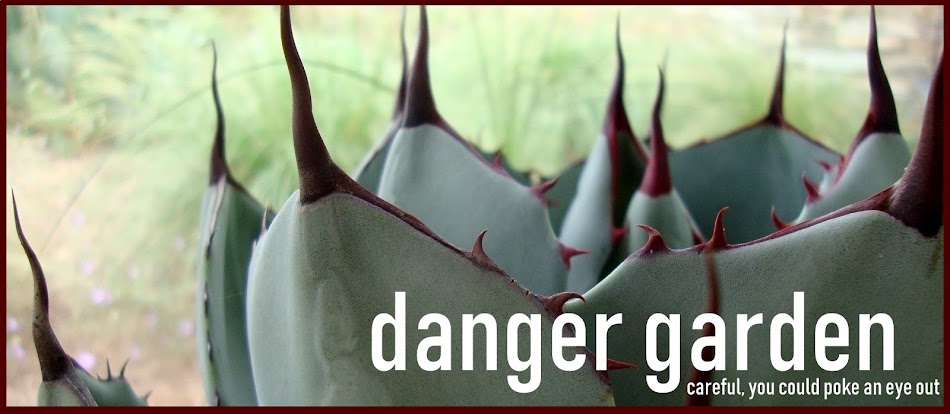 I love discovering a good vintage gardening book at a used book store, especially when it has great images. This one is small but full of vintage styled photos.
I love discovering a good vintage gardening book at a used book store, especially when it has great images. This one is small but full of vintage styled photos.Originally published in 1963 by the Southwestern Monuments Association there is a paragraph on the back cover that alludes to the novelty of color photography in that era “Captured by the magic of the color camera….Every color, from brilliant to delicate, is faithfully reproduced. This book will be a treasured photo album for those who have known the desert in bloom and a splendid introduction to the not yet initiated.” Remember the days when color photos in books were rare? And (gasp) the days of film, BEFORE digital photography?
I scanned a few of my favorite plant pages, hopefully the fact that this book is 47 years old means nobody will be coming after me for that. Maybe if I include a link to where you can buy a copy that will make it ok.
Soaptree yucca
 Joshua-tree and Torrey yucca
Joshua-tree and Torrey yucca Giant yucca and Sacahuista
Giant yucca and Sacahuista Sotol and Agave. The Dasylirion wheeleri (Sotol) is also called Desert Spoon. I never stopped to wonder why it’s called that but the text points out that the stiff leaf bases, when pulled from the cluster, form “desert spoons.”
Sotol and Agave. The Dasylirion wheeleri (Sotol) is also called Desert Spoon. I never stopped to wonder why it’s called that but the text points out that the stiff leaf bases, when pulled from the cluster, form “desert spoons.” Parry agave and Lechuguilla
Parry agave and Lechuguilla I found it interesting that in this text the Agaves are said to be part of the Amaryllis Family. I am certainly no expert but I know them as part of the Agavaceae family. Consulting my old stand by 'Agaves, Yuccas, and Related Plants: A Gardener's Guide', By Mary Irish and Gary Irish I found a lengthy history of the various families and the botanists that have sought to define them. They say that in 1911 Johannes P. Lotsy decided that the family Liliaceae needed “significant subdivisions,” it was then that the Agavaceae were separated from Amaryllidaceae and expanded upon. Reading the lengthy history I see that two different systems are currently in use one of which includes Agave, Beaucarnea, Beschorneria, Calibanus, Cordyline, Dasylirion, Doryanthes, Dracaena, Furcraea, Hesperaloe, Nolina, Polianthes, Prochnyanthes, Sansevieria, and Yucca in the family Agavaceae. The other restricts Agavaceae to the genera Agave, Beschorneria, Furcraea, Hesperaloe, Manfreda, Polianthes, Prochnyanthes, and Yucca. Confused? With uncertainty like that it’s no wonder that the plant professionals have trouble agreeing on names!
I found it interesting that in this text the Agaves are said to be part of the Amaryllis Family. I am certainly no expert but I know them as part of the Agavaceae family. Consulting my old stand by 'Agaves, Yuccas, and Related Plants: A Gardener's Guide', By Mary Irish and Gary Irish I found a lengthy history of the various families and the botanists that have sought to define them. They say that in 1911 Johannes P. Lotsy decided that the family Liliaceae needed “significant subdivisions,” it was then that the Agavaceae were separated from Amaryllidaceae and expanded upon. Reading the lengthy history I see that two different systems are currently in use one of which includes Agave, Beaucarnea, Beschorneria, Calibanus, Cordyline, Dasylirion, Doryanthes, Dracaena, Furcraea, Hesperaloe, Nolina, Polianthes, Prochnyanthes, Sansevieria, and Yucca in the family Agavaceae. The other restricts Agavaceae to the genera Agave, Beschorneria, Furcraea, Hesperaloe, Manfreda, Polianthes, Prochnyanthes, and Yucca. Confused? With uncertainty like that it’s no wonder that the plant professionals have trouble agreeing on names!Blue palo-verde and Bird-of-Paradise-flower. Notice the infamous “person for scale” included in the palo-verde picture.
 Saguaro and Organpipe cactus. For the longest time I thought the Organpipe was actually called the Oregonpipe, yes, I can be a dork.
Saguaro and Organpipe cactus. For the longest time I thought the Organpipe was actually called the Oregonpipe, yes, I can be a dork.



love vintage garden books! so cool this one is still available! thanks!
ReplyDeleteI love finding old garden books with great color plates. However, I have to keep them away from my wife as she is likely to cut them up to make greeting cards with. One of the local libraries is having a used book sale this weekend, and they sell them by the inch at great prices.
ReplyDeleteJanine, welcome.
ReplyDeleteLes, she wouldn't!!? Okay truth be told I've done that on occasion. Well actually I think I just cut out a few pictures and didn't even make anything out of them.